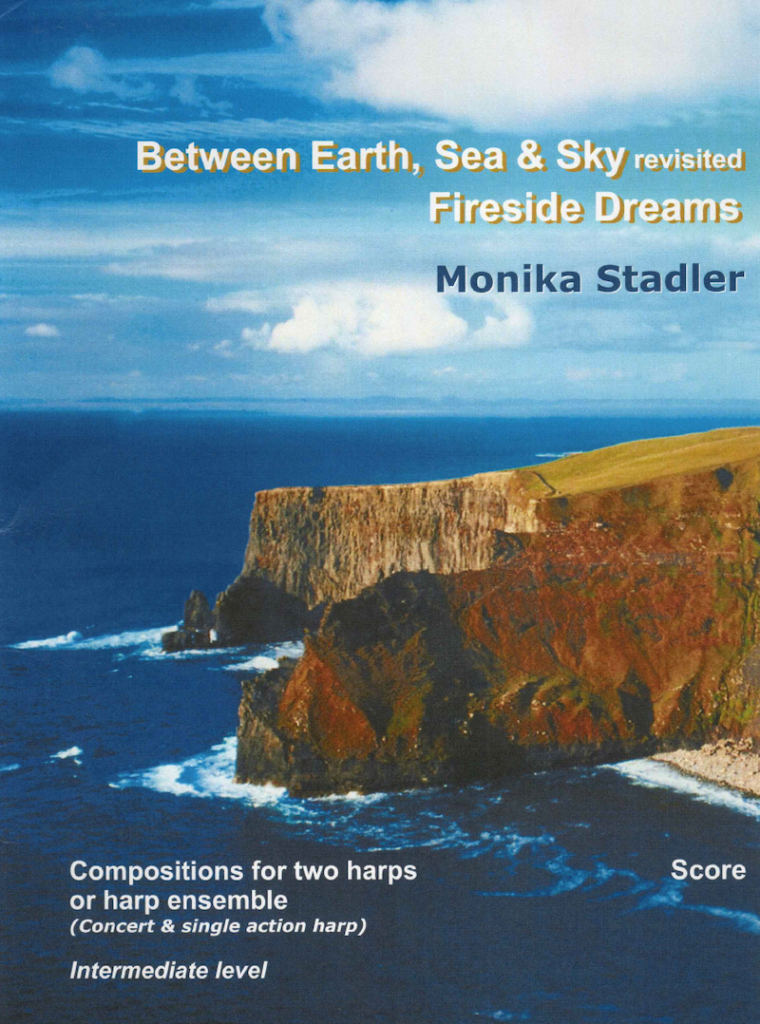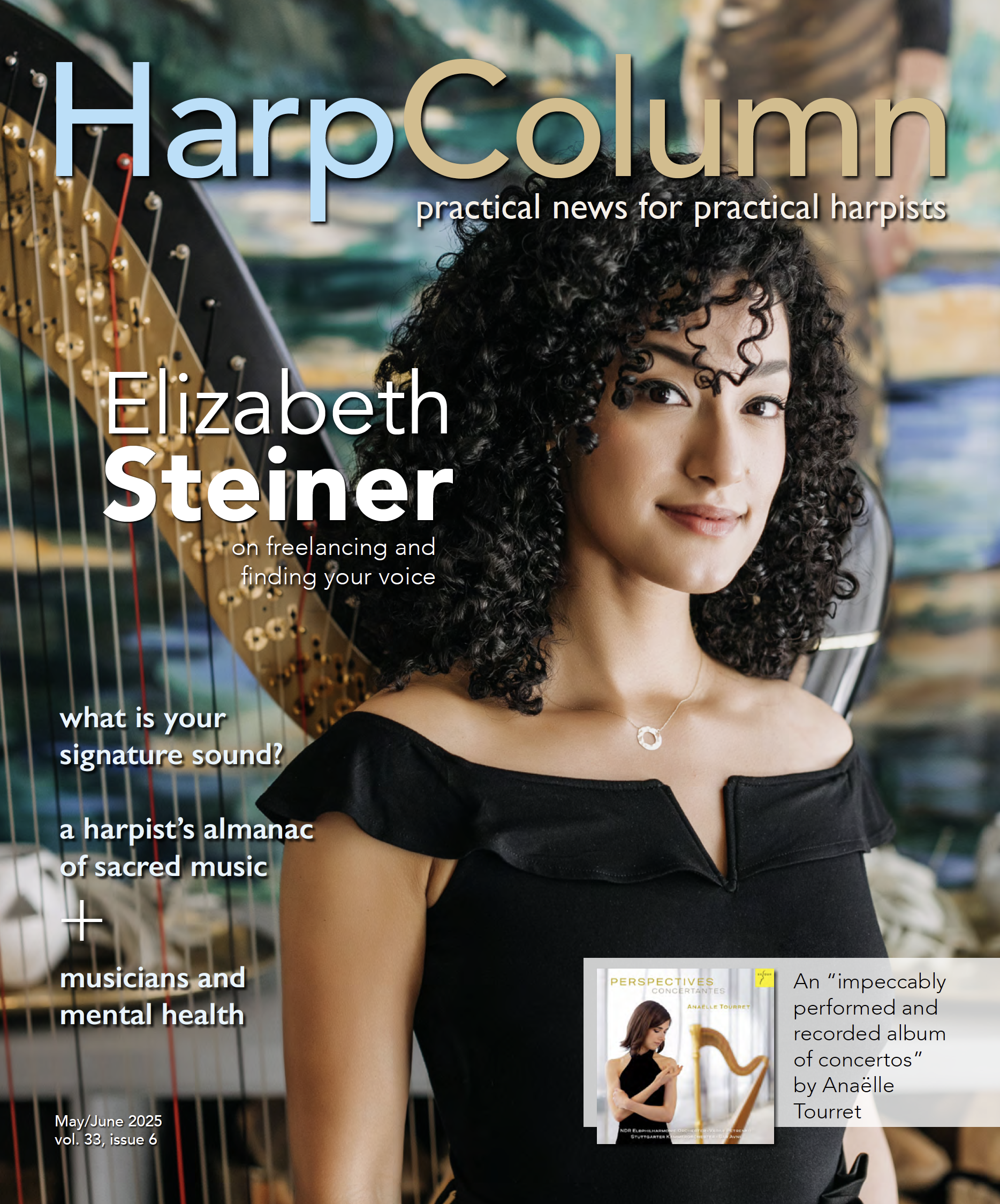

Left: “Santiago,” by harpist Cindy Horstman and bassist Michael Medina, is a harp duet with a “smooth, Latin jazz vibe.” Right: Two original works for harp duet by Austrian harpist Monika Stadler “offer something out of the ordinary” that can be played as a solo or duet.
It’s fun to play with other harpists in duos and ensembles. Most harp camps include harp ensembles, and the American Harp Society offers opportunities to play in harp ensemble at their national conferences. Harp ensembles are even going to be featured at the next AHS Institute in Texas in 2025. So, new repertoire for two or more harps is always welcome. There are some new publications that should be of interest.
Those who like jazz will enjoy an original composition co-written by Cindy Horstman and her 2Tone jazz duo partner, bassist Michael Medina. “Santiago” for two harps has a smooth, Latin jazz vibe. It is self-published and available through Horstman’s website, cindyhorstman.com, and Harp Column Music (HCM). You can hear a recording on both sites.
Harp 2 starts things off by establishing the bass line and chordal groove that continues throughout the entire three-plus minutes of the tune. Harp 2 is for pedal harp only, and there are several pedal changes. All of them are clearly marked below the staff. A few changes are fairly quick, but still doable. The page turns on this part are challenging and might have been a little easier if this had been taken into consideration when the music was typeset, but there is always a way to deal with this challenge.
Harp 1 enters at measure 9 and plays the melody throughout. This part can be played on pedal or lever harp, but there are no lever changes notated. It would require a lever harp tuned to A-flat to accommodate the D-flat that cannot be replaced by a C-sharp. All pedal changes are marked. There is one manageable page turn on this part.
Fingering is only suggested in a few places on both parts but should be fairly obvious to the intermediate level player. The music is also available as a harp solo, but it is a little more difficult to play.
Whether you play it with one or more other harpists or by yourself, “Santiago” is a hip tune that will appeal to the jazz lovers in your audience.
Creighton’s Collection has published two original works for two harps by Austrian harpist Monika Stadler. It is available to download at HCM. It is also available from Stadler’s website (harp.at) and the Creighton’s Collection website (cccd.co.uk). The music states these are for concert or single action pedal harp and intermediate level players.
The first melody, “Between Earth, Sea & Sky revisited,” has a new age feel. The composer tells us the music was “inspired by many walks along the spectacular coasts of Wales and Scotland.” You can listen to this on HCM. Written in E-minor, it is a very rhythmic piece in 4/4. Stadler advises Harp 1 can also be played as a solo (presumably after omitting the measures of rest or inserting that section from Harp 2).
The music begins with Harp 1 playing energetic sixteenth notes in a repetitive, upward pattern. Harp 2 enters at measure five with the same pattern an octave lower. This is followed by a theme established by Harp 1 that repeats throughout the piece. Harp 2 embellishes with harmonics and repeated xylophonic sounds. There are no pedal changes indicated on Harp 2. However, since some of the sons xylo notes are the same repeated note, you’ll probably want to play them with their enharmonic equivalent for a cleaner sound. This might not be possible on a single action harp. At m. 84, the fingering implies that you do play enharmonics, but there is no pedal notation.
There are several pedal changes in Harp 1, but only on the last page, and they are all notated in the center of the staff. Harp 1 also plays a section that sounds like improvisation before returning to the theme at the end. The music ends abruptly as if a thought was interrupted or making the piece seem unfinished. Perhaps this is Stadler’s clever way of making us want to hear more?
Fortunately, there is more, as the print version comes with a second composition, “Fireside Dreams.” Stadler asks us to “imagine sitting next to a fireplace on a cold winter’s day and start daydreaming.” Once again, Harp 1 may be played as a solo.
This is a charming melody in F-major and 3/4. It does indeed promote pleasant daydreaming with its lilting waltz tempo.
It begins with what appears to be an eight measure intro that is repeated. After that, a theme emerges in what seems to be an ABAB pattern with some pretty chord progressions. Pedal changes are notated. The music transitions into a section C before it changes time signature to 4/4 and the repetitive, energetic sixteenth note pattern that was used in the previous piece reappears for seven measures. There is one more measure of this in 6/4 before the intro heard at the beginning is reintroduced, again in 3/4. And, as in the previous piece, this one ends abruptly—as if in mid-phrase without any obvious resolution.
This distinctive treatment at the end doesn’t detract from the overall appeal of both pieces. It is simply different and, apparently, Stadler’s style. You can listen to a recording of this on Stadler’s aforementioned website.
The print version comes with a score and separate parts for both compositions. It is printed on oversized paper, and the typesetting is easy to read.
This publication offers something out of the ordinary that you could play alone or with another harpist. Listen and see what you think. •







